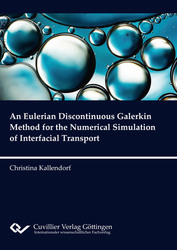| Departments | |
|---|---|
| Book Series (96) |
1378
|
| Nachhaltigkeit |
3
|
| Gesundheitswesen |
1
|
| Humanities |
2364
|
| Natural Sciences |
5406
|
| Engineering |
1793
|
| Engineering | 292 |
| Mechanical and process engineering | 862 |
| Electrical engineering | 686 |
| Mining and metallurgy | 30 |
| Architecture and civil engineering | 75 |
| Common |
98
|
|
Leitlinien Unfallchirurgie
5. Auflage bestellen |
|
Advanced Search
An Eulerian Discontinuous Galerkin Method for the Numerical Simulation of Interfacial Transport (English shop)
Christina Kallendorf (Author)Preview
Extract, PDF (130 KB)
Table of Contents, PDF (51 KB)
In various areas of interest, it is important to model, simulate and compute processes on surfaces. In fluid mechanics, a topic of increasing importance is the transport of mass, energy or momentum on phase interfaces. These processes are modelled by partial differential equations on the phase interface and therefore, on moving surfaces that may change rapidly with respect to geometry and topology.
In the present work, a numerical framework for solving interfacial convection-diffusion problems based on a Discontinuous Galerkin method is established. In contrast to most traditional approaches, the method introduced here maintains the original Eulerian grid as well as an implicit representation of the interface, rather than establishing a Lagrangian, i.e. interfacial grid. An MPI parallelized and modular software package for the numerical approximation of interfacial transport problems by polynomials of arbitrary order is presented. Well-posedness of the problem and computational efficiency are achieved by a narrow band structure around the moving interface. A pseudo-timestepping method is provided by which extended quantities can be extrapolated to new cells in this dynamic Narrow Band while being accurately preserved on the interface. The method constructed is then used to investigate different interfacial transport problems with and without diffusion numerically.
| ISBN-13 (Hard Copy) | 9783736994881 |
| ISBN-13 (eBook) | 9783736984882 |
| Final Book Format | A5 |
| Language | English |
| Page Number | 160 |
| Lamination of Cover | matt |
| Edition | 1. Aufl. |
| Publication Place | Göttingen |
| Place of Dissertation | Darmstadt |
| Publication Date | 2017-03-02 |
| General Categorization | Dissertation |
| Departments |
Mechanical and process engineering
|
| Keywords | Discontinuous Galerkin method, Numercial simulation, interfacial transport problems in two-phase flows, Surfactants, Eulerian Discountinuous Galerkin method, Level Set method, Stokes flow, incompressible flow, Direct Construction method |








